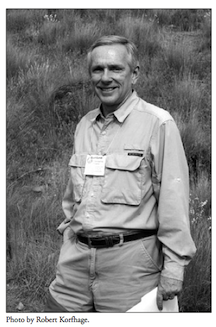Stu Garrett
Last Updated on March 23, 2024 by Tom Pratum

Physicians as botanists were common in the early exploration of the Northwest, including George Engelmann, Archibald Menzies, William Fraser Tolmie, William Tennant Gairdner, and John Strong Newberry.
Bend physician Stu Garrett carries on this physician-naturalist tradition, not exploring and reporting new species, but conserving Oregon’s native flora. It is particularly fitting that Garrett worked for protection and management of the Newberry Crater, which was named for Dr. John Strong Newberry, physician naturalist on the 1855 Topographic Corps Expedition that mapped future railroad routes.
Stu Garrett first became acquainted with the Native Plant Society of Oregon (NPSO) in Portland during his family medicine internship at the University of Oregon Medical School (now OHSU) in 1976. He read in the Oregonian that Ruth Hansen was leading a hike to the Columbia River Gorge to look at wildflowers. All were welcome. He was astounded at the energy and stamina of the 70-year-old trip leader as she bounded up the steep trails in the Gorge, identifying all of the flora on the way up. By the end of the hike, he was convinced that he wanted to be involved with this group of people.
When Stu moved to Bend, he was interested in organizing a similar group in Central Oregon. Unbeknownst to him, Joyce Bork had the same idea. (When NPSO was formed in 1961, there were no regional chapters, only a state-wide group centered in Portland.) The two plant lovers soon connected and co-founded the Central Oregon Chapter in 1979. Stu took on the positions of Fieldtrip Chairman and Conservation Committee Chair, leading numerous fieldtrips and avidly pursuing the protection of rare plants in central Oregon. He served as chapter president for over ten years and was a mainstay of organizing fieldtrips and meetings, including two state annual meetings. Stu served as President of the NPSO State Board in 1989 and 1990.
He instituted the swearing in of the NPSO President on a volume of Hitchcock with an appropriate tongue-in-cheek oath of office. But, the accomplishment that gave him the most satisfaction during his tenure was the initiation of NPSO’s annual journal, Kalmiopsis, in 1991. He served on its editorial board for ten years (1991 through 2002). He wrote two Plant of the Year articles: Western juniper (Juniperus occidentalis) in 1995 and basin wildrye (Leymus cinereus) in 2002, and was co-author with Berta Youtie of an Oregon Plants and Places article in 1992: The Painted Hills, Thirty Million Years of Phytogeography. He served on the State Board of Directors for many years between 1980 and 2002.
Stu’s interest in native plant communities let to involvement with the Oregon chapter of The Nature Conservancy and he eventually served on their Board for sixteen years. He has been a relentless force for control or eradication of weeds in central Oregon and has led and sponsored weed pulls and educational forums. He has been involved with endeavors to protect Peck’s penstemon (Penstemon peckii) in the Sisters area. He has encouraged the US Fish and Wildlife Service to increase protection for and reintroduction of the Malheur wirelettuce (Stephanomeria malheurensis).
His concern for protecting the rare pumice grapefern (Botrychium pumicola) led to his involvement in creating the Newberry National Volcanic Monument. He was chairman of the citizen’s committee that successfully sought Congressional designation of the Monument and was the Governor’s appointee and chairman of the Citizens Advisory Committee for the Monument. He is the author of The Newberry National Volcanic Monument: An Oregon Documentary and has written on numerous other historical and natural topics.
He has led natural history field trips for the High Desert Museum, The Nature Conservancy, NPSO, the Sierra Club, and a variety of other regional and statewide groups. In 2003 he was declared an “Earth Hero” by the Central Oregon Environmental Center, an annual award to an Oregonian for contributions to Oregon’s environment. In 2003 he won the Donald Kerr Award from the High Desert Museum for volunteer efforts to conserve Oregon’s High Desert ecosystems. Stu has worked tirelessly in serving the medical as well as the environmental community. Professional activities have included President of the Central Oregon Medical Society, Chair of the St. Charles Medical Center Credentials Committee, and Vice-Chair of the Deschutes County Commission on Children and Families.
He was named Oregon’s Doctor-Citizen of the Year by the Oregon Medical Association in 1991 and Bend’s Citizen of the Year in 1990 by the Bend Chamber of Commerce. He is the father of a daughter, Ragan, who attends the Oregon State University School of Veterinary Medicine. He is married to Hilary Garrett, a physical therapist in Bend.
